While people may know India’s diversity in culture, it is as diverse geographically too.
From Himalayas in the north to seas and oceans in the south and east, and deserts in the west, you can experience all.
While the treks in the Himalayas are famous, there are adventurous offbeat treks in India too.
This article will introduce you to 14 such offbeat treks in India recommended by travelers who have done those treks in different parts of India.
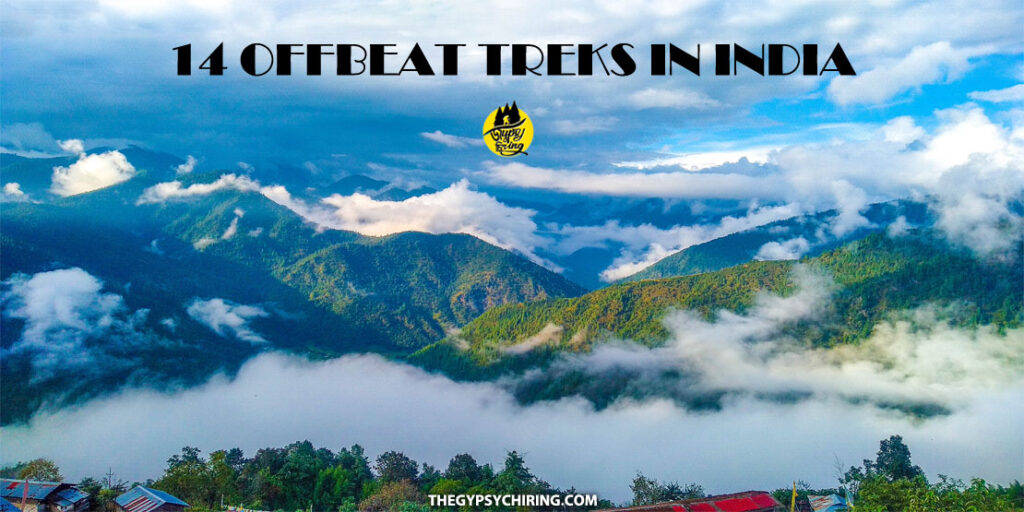
1. Treks in Northeast India
Northeast India is by far the least explored region in India.
The Eastern Himalayas of Arunachal Pradesh, the plateaus of Meghalaya, the Patkai Hills of Nagaland, the Lushai Hills of Manipur and Mizoram and the Borail Range of Assam are a hub of hiking and trekking trails.
Following are a few best treks in Northeast India–
Bamboo Trail Trek in Meghalaya
By Joydeep from The Gypsy Chiring
The Bamboo Trail Trek or the Mawryngkhang Trek in the northeastern state of Meghalaya is one of its kind.
The entire 4-5 km trail is made up of bamboo attached to the steep surface of the gorge with a river below it.
The Khasi people of Wahkhen village built the bamboo trail connecting to the legendary U Mawryngkhang rock.
The folklore associated with Mawryngkhang makes the trek even more interesting.

Wahkhen is also known as the Whistling Village of India after Kongthong Village which is also in Meghalaya. The Mawryngkhang trek is referred to as one of the scariest treks of Meghalaya.
The trek can be done all year round. The best time, however, would be post-monsoon. Wahkhen village is located about 49 km from the state capital Shillong.
Hiring a cab for the day would be a good choice considering there is no direct public transport from Shillong.
Both hostels and hotels are available in Shillong. For snacks and meals, you will find a shop at the starting point of the trek.
Dzukou Valley Trek in Nagaland
By Upasana Kakati from Unconventional and Vivid
The rolling hills sprinkled with yellow and white blooms stretched along with the stunning vistas of Dzukou Valley occasionally dotted with pink Dzukou lilies.
As the sun cast its first rays, the valley changed shades transitioning into hues of golden and dark green.
The valley is a masterpiece of nature spanning across the state of Nagaland and Manipur, India. The Nagaland side is more accessible with the Visvema route as the most popular and easy one.

The valley is a riot of colours with floral blooms and the best time to visit is from May to July, to witness the Dzukou lily.
The easiest way to reach Dzukou Valley is from Kohima which is around 17-20 km. Hire a cab to the base of Dzukou Valley or else take a shared cab and get down at Visvema or Zakhama.
It takes nearly 4 to 5 hours of trek to witness the vast expanse of green treeless knolls and rolling sweeps of contoured hillocks.
The trek along with the dwarf bamboo and rocky terrains takes you to the camping base of Dzukou Valley.
The valley is a picture postcard with treeless mounds of dwarf grass, colourful summer blooms, and some hillocks dotted with burnt trees standing as a reminder of how fragile the ecosystem is.
A crystal clear rivulet and stream flow through a valley with hidden deep-cut ravines, caves, and waterfalls sculpting the valley naturally to perfection.
At the Dzukou Valley Campsite, you can either pitch your tent or stay in the dorm. However, there is a nominal fee for both. Food is available on payment.
Monpa Trail Trek in Arunachal Pradesh
By Joydeep from The Gypsy Chiring
The Monpa Trail Trek is a new trekking trail that starts from the Sangti Valley of Dirang in Arunachal Pradesh and passes through Khalibok Village leading to the top of the topmost village Chander.
One can enjoy the majestic views of Gorichen Peak (6858m) from Chander. The trek can be concluded either at Pangma or Thembang villages.

The latter is also a UNESCO World Heritage Site. The trek is named after the Monpa ethnic group which are the local inhabitants of the area.
I must say, the state of Arunachal Pradesh has some of the best trekking places in India.
The best time to do the Monpa Trail Trek is from October to February. Chander receives snow in winter and you may also have the chance to experience the Losar Festival in February.
We stayed at the Letro Homestay & Campsite, located beside the Sangti River.
There are two routes to reach Dirang, one starts from Tezpur of Assam and the other via Udalguri of Assam. If you start from Guwahati in Assam, take the 2nd route as it is relatively shorter.
Mount Saramati Trek in Nagaland
By Joydeep from The Gypsy Chiring
Saramati Peak at an altitude of 3841 m above sea level stands tall signifying the border of India and Myanmar in the state of Nagaland. Mt. Saramati is the highest peak in Nagaland.
The topography, the continuous ascend and descent of hills, the right-angled rock walls to climb, vibrant pink, yellow and white flowers post-monsoon, and the snow in winter- Mt. Saramati is one of the best and the least trekked mountains in India.
The Thanamir Village from where the trek starts is also famous for its apple cultivation.
The best time to visit Mt. Saramati is in September for colourful flowers and in winter for snowfall. The nearest railway station is Dimapur Railway Station.
To reach Thanamir, you have to first go to Kohima from Dimapur, followed by 12 hours of travel to Pungro and then another 5 hours of driving to Thanamir.
In Kohima, you may stay at Morung Lodge, Central Guest House and Dawn Homestay while at Pungro and Thanamir, the Govt Guest House and the Thanamir Guest House respectively.
There are many options for non-veg food in Nagaland. However, boiled vegetarian cuisines like Hinkejvu are worth trying.
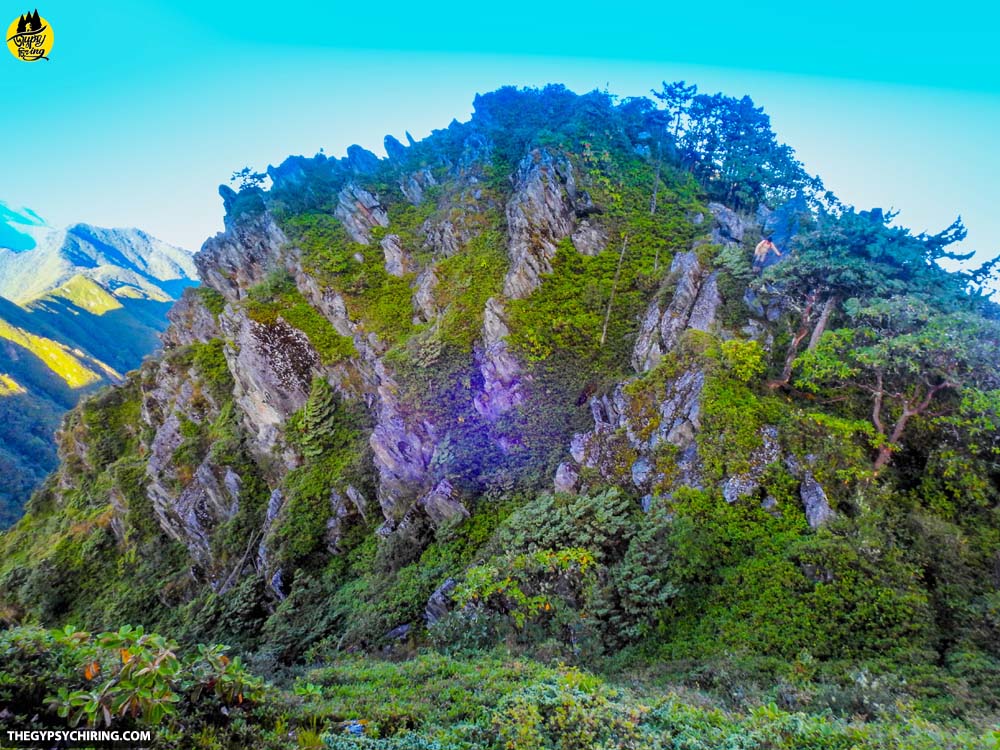
Seven Lakes Trek in Arunachal Pradesh
By Joydeep from The Gypsy Chiring
The virgin forests and mountains of Anini in the Dibang Valley of Arunachal Pradesh possess some of the most alluring lakes in India.
The Seven Lakes Trek will take you to Kamuh-ya Lake, Emuh-ya Lake, Emu Lake, Dini Lake, Che-ne Lake and the two Huhu Lakes tucked into hills of the Eastern Himalayas. The 7-day trek involves 5-6 hours of trekking every day.
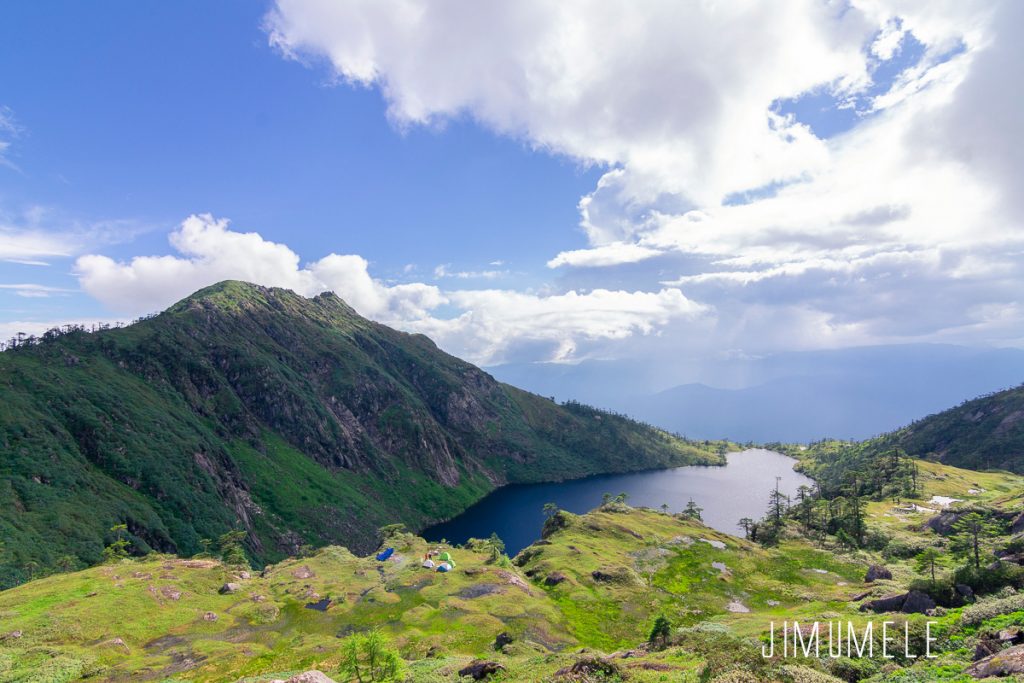
The Idu Mishmi folklores associated with each of these lakes make them even more interesting. Seven Lakes Trek is by far one of the most beautiful treks in India.
The monsoon seasonal flowers bloom in June and July. The ideal time to do the trek is however in August and September for better weather conditions.
Winter treks have not been opened to trekkers yet. If you wish to do the trek, contact Jimu Mele who runs Dibang Valley Trekkers (Emudu Seven Lakes Trekkers).
The Seven Lakes Trek Starts from Anini the district headquarters of the Upper Dibang Valley District of Arunachal Pradesh.
The nearest railway station is in Tinsukia from where you can avail buses to Roing.
Buses and shared cars from Roing to Anini start early in the morning. Make sure you book one the previous day.
2. Treks in Western India
Western India comprises the states – Goa, Gujarat, Maharastra, and Rajasthan.
It also covers the two union territories Dadra and Nagar Haveli and Daman and Diu. Semi-arid conditions, deserts and the Western Ghats dominate the region.
Devkund Waterfall Trek in Maharashtra
By Avantika from Wayward Wayfarer
Devkund Waterfall is a mesmerising waterfall tucked within the rolling hills of the Western Ghats in Maharashtra. It is believed that the River Kundalika originates from this waterfall.
The hike to the waterfall is a great day hike for people looking for some adventure near cities like Pune and Mumbai.
The trek to Devkund Waterfall starts at a village called Bhira. The trail is easy and well-marked mostly through flat meadows, apart from the few gradual slopes.

At Bhira, a few dhabas are serving proper meals, as well as basic stay options. Throughout the trail, one can also find shacks for quick snack stops.
Post-monsoon from October to November is the best time to visit this waterfall as the water becomes crystal clear and it is possible to swim in the pool.
Many people also prefer going in the monsoons for the mystical atmosphere but swimming would not be possible and the water would be muddy during the rainy season.
3. Treks in North India
Comprised of the Himalayan states such as Himachal Pradesh and Uttarakhand and the union territories Ladakh and Jammu and Kashmir, trekking in North India is very popular among the adventure and mountaineering communities of India.
Here are a few offbeat treks in Northern India-
Beas Kund Trek in Himachal Pradesh
By Rachita from MeanderWander
Beas Kund Trek is one of the most exciting treks to do in the Himalayas that not many people are aware of.
As you traverse through green landscapes and majestic mountains, you breathe in the fresh air and cover a maximum altitude of 12,772 ft.

This trek gives you a glimpse of not only the gorgeous Beas Lake but also of summit views of huge mountains in Himachal Pradesh such as Friendship Peak, Hanuman Tibba, Shitidhar, and more.
One of the best things about this trek is the colourful landscape and the pollution-free sky that makes it easy for visitors to look at the Milky Way.
If you wish to truly enjoy this trek, then the best time to go on the trek is between August – October.
You can take your own tent and food provisions for this trek as you won’t find anything nearby. The starting point of the trek is from Dhundi in Manali can be reached by car or you can take a bus going to Solang Valley.
If you hire a car, you could avoid 2-3 km of trekking but with a bus, the trekking time to the lake base camp would increase.
Kartik Swami Trek in Uttarakhand
By Jitaditya from The Travelling Slacker
Shiva and Ganesh temples can be found all over India but Kartikeya temples are rare, especially in northern India.
That’s what makes this short trek a unique one as you reach a Kartikeya Temple at the end of the trek.
The main draw of the Kartik Swami trek though has always been the views. At the height of 3000 metres, you get 360-degree views of the much higher peaks in all directions.
The entire route is through a rhododendron forest so it’s best done during the spring season when they’re in full bloom.

The approach is from a small village called Kanakchouri, a couple of hours from Rudraprayag, which is a major town.
It’s not a very long trek and can be wrapped up in a day. You’ll find a resort in Kanakchouri but you can even come back to Rudraprayag the same day.
Miyar Valley Trek in Himachal Pradesh
By Jitaditya from The Travelling Slacker
Miyar Valley Trek offers you a feel of both Himachal and Ladakh. Miyar is a sub-valley of Chandrabhaga and a part of the Lahaul region. A difficult trail even connects it to Zanskar, which hardcore people can try.
However, here I’m talking about the comparatively simpler trek that takes you to the high-altitude plains beyond the last inhabited villages of the Miyar region.
Nomadic Gaddi herders with their sheep and goats are the only regular visitors of these pastures crisscrossed by slender glacial rivers.
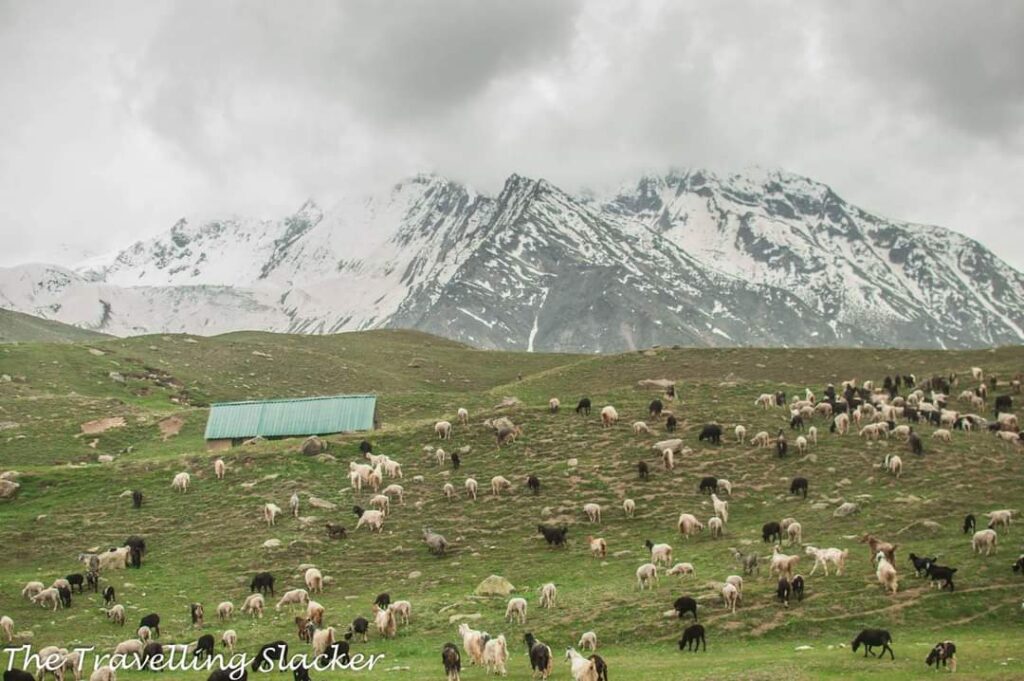
In the summer, these desolated meadows above 3000 meters also get covered with delirious wildflowers, in the midst of which you can camp and explore.
That’s why it’s best explored between May to September (although be prepared for rains in the monsoon).
The easiest way to reach Miyar is to take a morning bus from Keylong and reach Shukto village, where the road ends. That’s where you will also find a homestay.
Beyond that, you’ll have to camp. Have at least 3 days in hand for decent exploration inside the valley excluding the commutation time.
If you want to reach Keylong from Delhi, you can take a bus from Delhi to Manali. Next, you can board a bus, and hire or rent a car that goes to Keylog from Manali.
Sham Valley Trek in Ladakh
By Ellie from Soul Travel India
Famously known as the ‘baby trek’ in Ladakh, the Sham Valley trek is the perfect introduction to Ladakh trekking.
It’s not an easy-going route, but one of the best things about the Sham Valley route is it takes you from local homestay to local homestay, allowing you to interact with locals and experience Ladakh village life along the way.
The trek runs through the Sham Valley, with elevations between 3,200 – 3,900 meters (lower than most other Ladakh treks which go much higher).
The trek is designed so that you’re trekking for 4-5 hours per day, with plenty of time in the afternoons and evenings to enjoy the surroundings or chat with the owners of the simple homestays you’ll stay in. Mobile phone reception is non-existent, so bring a good book!

The starting point for the trek is from Lekir Monastery, about an hour outside of Leh.
The best way to do this trek is to hire a local guide through a tour company – the package price will include your guide, transportation of your main luggage between homestays, and the cost of your accommodations.
Homestays are simple, usually without piped water, but the welcome is warm.
Although you could do the trek by yourself with careful planning and research if you’re an experienced hiker, I recommend supporting the local tourism industry by hiring a guide where possible. I used SkyWalker Travel, located in Leh.
Surkanda Devi Trek in Uttarakhand
By Subhadeep from My Travel Frames
Located at an altitude of 2700 metres from sea level, Surkanda Devi Temple is one of the 51 Shakti Peeth in the Indian subcontinent.
Apart from its religious significance, the temple premises offer one of the best panoramic views of the surrounding Himalayas, including a few snow-capped mountains.
The Surkanda Devi Trek is an hour-and-a-half uphill trek from the nearest base point. Although the gradient is steep, you can still complete it with a moderate fitness level.
The pavement goes up through a dense forest and provides an amazing walkway for trekkers while enjoying nature apart from the occasional horses and mules when you have to give way.
In contrast, the natural walkway takes a little more time and attracts seasonal hikers more often.

You can do this trek around the year, even in monsoon, as the cemented walkway works perfectly at that time.
However, if you want a clear view of the Himalayas, winter is the best time to go for this trek, while in summer, the Ganga Dussehra festival attracts many visitors here.
You can stay in Mussoorie, Dhanaulti or Kanatal and take a morning cab to Kaddukhal, from where you have to start your trek. There are several economy and luxury hotels available in Mussoorie.
At Kaddukhal, there are a few roadside shops where you can get snacks and noodles.
In addition, there are a few small shacks at the midpoint of the cemented walkway where you can drink a glass of Burans (Rhododendron) juice to rejuvenate yourself.
The nearest airport is Jolly Grant Airport in Dehradun, 98 kilometres away, whereas Dehradun Railway Station is 65 kilometres from Kaddukhal.
4. Treks in South India
Though the southern part of India is surrounded by seas and oceans, the presence of Eastern and Western Ghats provides ample scope for adventurous activities like trekking in some of the unique trails for trekking in South India.
Following are some of the best treks in South India–
Gokarna Beach Trek in Karnataka
By Ellis from Backpack Adventures
When you think about trekking in India, you probably think about the country’s beautiful mountainous landscapes.
However, it is also possible to hike along its beautiful coast. The Gokarna beach trek is getting increasingly popular and for good reasons.
The small pilgrimage town of Gokarna in Karnataka has several palm-fringed beaches that offer a more quiet and relaxed alternative to the more popular Goa.
Some of these beaches are so remote that they can only be accessed by boat or on foot. All beaches are connected by a hiking trail that is about 8 kilometres in total.

You need sturdy shoes to climb over the rocky terrain, but you are guaranteed spectacular views over the Arabian Sea. In between, you can take a break while taking a dip in the ocean.
Gokarna is easy to reach by bus or train from Goa, Bangalore or Mysore. The nearest airport is in Mangalore.
The best time to visit Gokarna is from October till March when the weather is pleasant and dry. Kudlee Beach offers some of the best accommodation options.
The Namaste yoga farm even has a treehouse. Nearby you can choose between several restaurants on the beach.
Kolukkumalai Trek in Tamil Nadu
By Sinjana from Backpack and Explore
Kolukkumalai is a picturesque hamlet in Tamil Nadu which is home to the highest organic tea garden in the world.
Besides the breathtaking views of the valley, Kolukkumlai is also one of the few places in India where you can see the Neelakurinji blossoms.
Neelakurinji is one of the rarest types of flower that covers parts of the Nilgiri Hills once every 12 years.
Kolukkumalai looks glorious throughout the year, even during heavy monsoons. However, it’s safe to avoid the monsoon months for this trek.
The 12km long trek through the enchanting hills starts from Kurangani village at 3800 feet, goes through the grasslands, and pine forests and up to the tea gardens.
The treks are organized by some organisations like Bangalore Mountaineering Club, Treks and Trails, etc.

This is a difficult trek that includes overnight camping under the stars and waking up to the scintillating sunrise. For accommodation, you can choose nearby hotels of Munnar or the permanent campsites of Black Eagles Camp at Suryanelli.
Kumara Parvatha Trek in Karnataka
By Raksha from SoloPassport
Kumara Parvatha, at a height of 1712 metres, is the most rewarding trek in the Western Ghats and is considered the toughest mountain to conquer among trekkers.
The trek to Kumara Parvatha summit is about 28 kilometres in total and takes multiple days of trekking. It requires a good fitness level as the trail is steep throughout the trek.
Kukke Subramanya is the base and starting point of the trek, and the town is an overnight bus journey of 280 kilometres from Bangalore City.
A permit needs to be obtained to trek in the national park which can be received from the forest officials at the forest checkpoint.

The forest checkpoint is 7 kilometres (climb) from the base of the mountain.
As it is a multi-day trek, one needs to camp along the trail. The best place to camp for the night is at the forest checkpoint. Note that the camping site has very limited facilities.
The camping gear, water and food for all days need to be carried along as there are no shops or water stations on the trail.
I hope you found this article on offbeat treks in India helpful. Let me know if I should add more treks to this list.

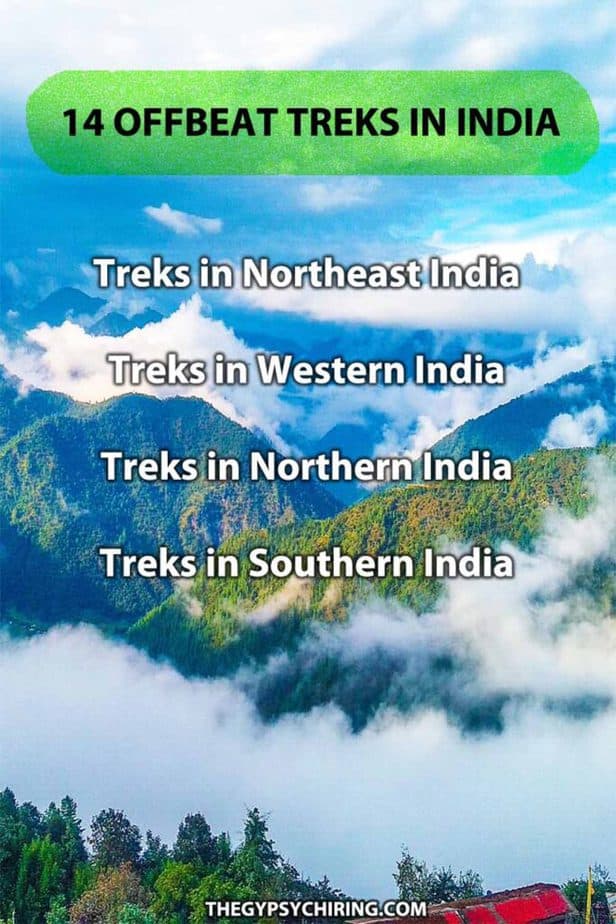
I like trekking in Himalayas. Thanks for the informative article.
Hi Vignesh. Cheers to the love for treks in the Himalayas. I am glad to know that you found it informative.
North India is one of my favorite places to go for trekking. This is a very informative blog and has detailed a lot about some of the must-visit places in this region. I appreciate the effort.
Definitely makes me want to go exploring!
I hope you have a good time when you come here, Krysten.
Very Informative! Thank you
Thank you Kezha.